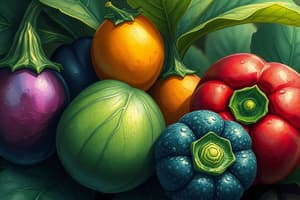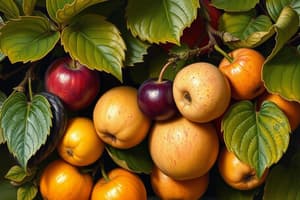Podcast
Questions and Answers
What defines a fruit according to its biological role in flowering plants?
What defines a fruit according to its biological role in flowering plants?
- Any part of the plant involved in photosynthesis
- The mature ovaries of flowering plants (correct)
- The flexible green stems of plants
- The edible part of a herbaceous plant
Which of the following is NOT classified as a tuber?
Which of the following is NOT classified as a tuber?
- Potato
- Carrot (correct)
- Beetroot
- Sweet potato
Which of the following classifications pertains specifically to flowers?
Which of the following classifications pertains specifically to flowers?
- Stone Berries
- Stone Fruits
- Aggregate Fruits (correct)
- Ovarian Fruits
What is the main purpose of fruit development?
What is the main purpose of fruit development?
Which structure of the flower is responsible for housing the ovary?
Which structure of the flower is responsible for housing the ovary?
What type of fruit is characterized by a single ovary and is often fleshy?
What type of fruit is characterized by a single ovary and is often fleshy?
Which of the following are classified under roots?
Which of the following are classified under roots?
What structure in the flower is defined as the female reproductive part and can consist of multiple carpels?
What structure in the flower is defined as the female reproductive part and can consist of multiple carpels?
Which of the following is NOT a characteristic of citrus fruits?
Which of the following is NOT a characteristic of citrus fruits?
What defines a true berry?
What defines a true berry?
Which type of fruit is characterized by a core that is usually not eaten?
Which type of fruit is characterized by a core that is usually not eaten?
Which pigment is responsible for the yellow, orange, red, and purple colors in many fruits and vegetables?
Which pigment is responsible for the yellow, orange, red, and purple colors in many fruits and vegetables?
Which of the following statements about fleshy fruits is true?
Which of the following statements about fleshy fruits is true?
Chlorophyll is primarily responsible for which of the following in plants?
Chlorophyll is primarily responsible for which of the following in plants?
What property distinguishes stone fruits from other types of fruits?
What property distinguishes stone fruits from other types of fruits?
Which of the following nutrients is primarily found in carotenoids?
Which of the following nutrients is primarily found in carotenoids?
What is a primary health benefit of flavonoids?
What is a primary health benefit of flavonoids?
Which of the following is a good source of potassium?
Which of the following is a good source of potassium?
Why is it recommended to select whole or cut-up fruits over fruit juices?
Why is it recommended to select whole or cut-up fruits over fruit juices?
Which type of flavonoid is found in berries?
Which type of flavonoid is found in berries?
What characteristic does pectin provide to plants?
What characteristic does pectin provide to plants?
Which benefit is associated with phytochemicals?
Which benefit is associated with phytochemicals?
What should you look for when selecting canned fruits?
What should you look for when selecting canned fruits?
What is a benefit of eating vegetables that are low in calories?
What is a benefit of eating vegetables that are low in calories?
What is the primary benefit of adding pectinase enzyme to juice?
What is the primary benefit of adding pectinase enzyme to juice?
Which of the following fruits is known to have a high tannin content?
Which of the following fruits is known to have a high tannin content?
Enzymatic browning in fruits primarily involves which combination of substances?
Enzymatic browning in fruits primarily involves which combination of substances?
What is the role of intercellular air spaces in fruits and vegetables?
What is the role of intercellular air spaces in fruits and vegetables?
Which acid is commonly found in citrus fruits?
Which acid is commonly found in citrus fruits?
How does soaking fruits in citrus juices help prevent browning?
How does soaking fruits in citrus juices help prevent browning?
Which factor does NOT contribute to the juiciness of fruits and vegetables?
Which factor does NOT contribute to the juiciness of fruits and vegetables?
What is the optimal pH for polyphenol oxidase when preventing browning?
What is the optimal pH for polyphenol oxidase when preventing browning?
What is the purpose of blanching vegetables?
What is the purpose of blanching vegetables?
How should ripe fruit with high water content be stored?
How should ripe fruit with high water content be stored?
Which of the following is true about climacteric fruits?
Which of the following is true about climacteric fruits?
What is the optimal humidity range for storing most vegetables and fruits?
What is the optimal humidity range for storing most vegetables and fruits?
Why should onions not be refrigerated?
Why should onions not be refrigerated?
What happens when potatoes are refrigerated?
What happens when potatoes are refrigerated?
Which type of vegetables typically has a shorter storage time?
Which type of vegetables typically has a shorter storage time?
What is recommended for storing unripe tomatoes?
What is recommended for storing unripe tomatoes?
Flashcards
Vegetable
Vegetable
Edible part of a herbaceous plant, typically grouped by eaten plant part (leaves, stems, roots).
Fruit
Fruit
Mature ovary of a flowering plant; develops seeds after fertilization.
Simple Fruit
Simple Fruit
Fruit derived from a single carpel (part of the flower).
Aggregate Fruit
Aggregate Fruit
Signup and view all the flashcards
Pistil
Pistil
Signup and view all the flashcards
Carpel
Carpel
Signup and view all the flashcards
Fruit Development
Fruit Development
Signup and view all the flashcards
Vegetable-Fruits
Vegetable-Fruits
Signup and view all the flashcards
Citrus Fruits
Citrus Fruits
Signup and view all the flashcards
Fleshy Fruits
Fleshy Fruits
Signup and view all the flashcards
Pomes
Pomes
Signup and view all the flashcards
Stone fruits (Drupes)
Stone fruits (Drupes)
Signup and view all the flashcards
Carotenoids
Carotenoids
Signup and view all the flashcards
Lycopene
Lycopene
Signup and view all the flashcards
Chlorophyll
Chlorophyll
Signup and view all the flashcards
True berries
True berries
Signup and view all the flashcards
Flavonoids
Flavonoids
Signup and view all the flashcards
Anthocyanins
Anthocyanins
Signup and view all the flashcards
Water-soluble Vitamins
Water-soluble Vitamins
Signup and view all the flashcards
Dietary Fiber
Dietary Fiber
Signup and view all the flashcards
Potassium
Potassium
Signup and view all the flashcards
Phytochemicals
Phytochemicals
Signup and view all the flashcards
Potassium in Foods
Potassium in Foods
Signup and view all the flashcards
Pectinase enzyme
Pectinase enzyme
Signup and view all the flashcards
Tannins
Tannins
Signup and view all the flashcards
Enzymatic Browning
Enzymatic Browning
Signup and view all the flashcards
Intercellular air spaces
Intercellular air spaces
Signup and view all the flashcards
Juiciness
Juiciness
Signup and view all the flashcards
Organic acids
Organic acids
Signup and view all the flashcards
Preventing browning
Preventing browning
Signup and view all the flashcards
Maintaining green color
Maintaining green color
Signup and view all the flashcards
Blanching
Blanching
Signup and view all the flashcards
Blanching Function
Blanching Function
Signup and view all the flashcards
Climacteric Fruits
Climacteric Fruits
Signup and view all the flashcards
Non-Climacteric Fruits
Non-Climacteric Fruits
Signup and view all the flashcards
Storing Ripe Fruits
Storing Ripe Fruits
Signup and view all the flashcards
Storing Unripe Fruits
Storing Unripe Fruits
Signup and view all the flashcards
Storing Vegetables in the Fridge
Storing Vegetables in the Fridge
Signup and view all the flashcards
Storing Onions and Potatoes
Storing Onions and Potatoes
Signup and view all the flashcards
Study Notes
Fruits & Vegetables - Definitions
- Vegetables are the edible parts of herbaceous plants.
- Herbaceous plants have flexible stems with little to no woody part.
- Vegetables are often grouped by the edible part, like leaves, stems, or roots.
Fruits - Definitions & Classification
- Fruits are the mature ovaries of flowering plants.
- Ovaries contain seeds that develop after fertilization.
- Fruits' main purpose is to spread plant seeds.
- Fruit classifications include: Simple, Aggregate, Multiple, and Accessory.
Parts of a Plant
- Fruits: Avocado, cucumber, eggplant, okra, pepper, pumpkin, snap beans, squash, tomato
- Flowers: Artichoke, broccoli, cauliflower
- Stems & Shoots: Anise (fennel), asparagus, celery, kohlrabi
- Leaves: Beet greens, bok choy, Brussels sprouts, cabbage, chard, Chinese cabbage, collards, dandelion greens, endive, escarole, kale, lettuce, mustard greens, parsley, romaine spinach, turnip greens, watercress
- Tubers: Ginger root, potato, sunchoke
- Roots: Beet, carrot, celeriac, jicama, parsnip, radish, rutabaga, sweet potato, turnip
- Seeds: Beans, corn, lentils, peas
Pigments & Nutrients
- Carotenoids: Fat-soluble pigments (yellow, orange, red, purple) with antioxidant properties. Examples: carotene, lycopene, xanthophyll, lutein, zeaxanthin. Found in carrots, oranges, peaches, pineapples, red peppers, tomatoes, and winter squashes.
- Chlorophyll: Fat-soluble pigment, slightly soluble in alkaline media, responsible for green color in plants and algae. Essential in photosynthesis.
- Flavonoids: Water-soluble pigments with antioxidant properties. Some examples: anthocyanin, anthoxanthin, betalains. Found in berries, cauliflower, onions and beet roots.
Nutrients & Health Benefits
- Good sources of dietary fiber, potassium, folate, vitamin A, and vitamin C.
- Commonly low in fat and calories, and cholesterol free.
- Phytochemicals offer anti-inflammatory, anti-oxidant, and anti-cancer effects.
Vegetable & Fruit Storage
- Fruits: Store ripe fruits for a shorter period, unripe in a paper bag. Grapes are best stored unwashed in refrigerator in plastic bag.
- Vegetables: Store at room temperature or in the refrigerator depending on the type of vegetable. Keep vegetables in refrigerated crisper drawer to preserve moisture and to maintain freshness.
Browning of Fruits & Vegetables
- Tannins: Naturally occurring polyphenols; bitter taste and astringent feeling. Common in unripe fruits.
- Enzymatic browning: Reaction of tannins with PPO enzymes in presence of oxygen.
- To avoid browning: heat, acid, cold temperatures (inhibits, but doesn't prevent), and antioxidants (ascorbic acid & sulfur compounds).
Preparation Methods to Preserve Color
- Blanching: Foods cooked briefly in boiling water, then plunged in ice water. This helps retain color and stops the cooking process.
Ripening and Storage
- Climacteric Fruits: Continue ripening after harvest (e.g., apples, avocados, bananas, tomatoes).
- Non-climacteric Fruits: Best ripen before harvest (e.g., blueberries, cherries, grapes, strawberries).
Sensitivity to Cold
- Non-chilling-sensitive commodities: Do not need to be stored in cold temperatures (e.g., Apple, Apricot, Avocado, Banana...).
- Chilling-sensitive commodities: need specific temperatures (e.g., bananas, melons, sweet potatoes).
Definitions of Fruit Types
- Berries: Fleshy fruits without a pit, entire ovary wall in a single flower.
- Citrus Fruits: Typically sour, with a waxy outer layer. Rich in vitamin C.
- Fleshy Fruits: Thick, soft, and succulent fruits. Larger in size, sometimes seeds edible along with the flesh e.g. melons and papaya.
- Pomes: Fruits with a central core surrounded by edible flesh and a tough outer layer. Apples and pears.
- Stone Fruits (Drupes): Have pulp on the outside and an inedible large, hard stone in the middle, plums, cherries, peaches, and mangoes.
Acidity in Fruits
- Acidity is due to organic acid in the vacuole.
- Acidity decreases as fruits ripen.
- Volatile and non-volatile acids.
- Common organic acids: citric, malic, tartaric, oxalic.
Studying That Suits You
Use AI to generate personalized quizzes and flashcards to suit your learning preferences.



